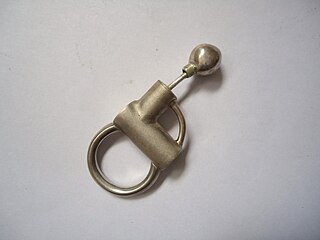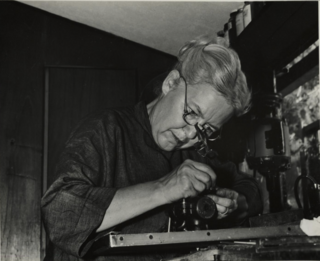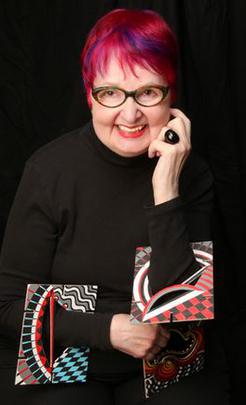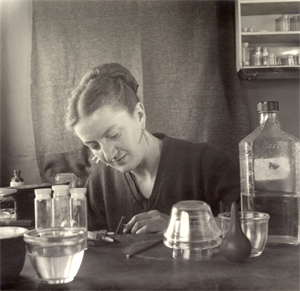
Jewellery consists of decorative items worn for personal adornment such as brooches, rings, necklaces, earrings, pendants, bracelets, and cufflinks. Jewellery may be attached to the body or the clothes. From a western perspective, the term is restricted to durable ornaments, excluding flowers for example. For many centuries metal such as gold often combined with gemstones, has been the normal material for jewellery, but other materials such as glass, shells and other plant materials may be used.

René Jules Lalique was a French jeweller, medallist, and glass designer known for his creations of glass art, perfume bottles, vases, jewellery, chandeliers, clocks, and automobile hood ornaments.

A brooch is a decorative jewellery item designed to be attached to garments, often to fasten them together. It is usually made of metal, often silver or gold or some other material. Brooches are frequently decorated with enamel or with gemstones and may be solely for ornament or serve a practical function as a clothes fastener. The earliest known brooches are from the Bronze Age. As fashions in brooches changed rather quickly, they are important chronological indicators. In archaeology, ancient European brooches are usually referred to by the Latin term fibula.

Wearable art, also known as Artwear or "art to wear", refers to art pieces in the shape of clothing or jewellery pieces. These pieces are usually handmade, and are produced only once or as a very limited series. Pieces of clothing are often made with fibrous materials and traditional techniques such as crochet, knitting, quilting, but may also include plastic sheeting, metals, paper, and more. While the making of any article of clothing or other wearable object typically involves aesthetic considerations, the term wearable art implies that the work is intended to be accepted as an artistic creation or statement. Wearable art is meant to draw attention while it is being displayed, modeled or used in performances. Pieces may be sold and exhibited.

Architectonic jewellery is a subset of Constructivist studio jewellery that makes use of architectural forms and ideas in the much smaller-scale format of jewellery. Some of the defining elements of architectonic jewellery are linearity, inclusion of geometric elements, undisguised structural elements, and use of varying depth to convey a sense of design in three dimensions rather than only two. Certain architectonic pieces include moving parts, which enables "extending or reconfiguring" the pieces by the wearer. Architectonic jewellery often incorporates materials more typically used in engineering such as stainless steel and niobium, reinforcing the association with architecture.

Mary Lee Hu is an American artist, goldsmith, and college educator, known for using textile techniques to create intricate woven wire jewelry.

Peter Macchiarini was an American Modernist jeweler and sculptor, who was a pioneer in the field of avant-garde jewelry. He maintained an art studio and shop on Grant Avenue in San Francisco, California, for more than 50 years. He was instrumental in organizing the first San Francisco outdoor art festival in 1938 as well as founding the Upper Grant Avenue Street Fair in 1954, an event that spawned similar artist-run festivals in the San Francisco Bay Area.
Linda MacNeil is an American abstract artist, sculptor, and jeweler. She works with glass and metal specializing in contemporary jewelry that combines metalwork with glass to create wearable sculpture. Her focus since 1975 has been sculptural objets d’art and jewelry, and she works in series. MacNeil’s jewelry is considered wearable sculpture and has been her main focus since 1996.

Lisa Gralnick is an American contemporary metalsmith, studio jeweler and academic. She works in the field of craft and art jewelry. Gralnick says: "I have chosen to make jewelry, which is traditionally considered 'craft', and I do enjoy the processes and techniques that allow me to execute my work without technical faults. But 'craft' is only a means to an end for me, as it is for many artists. My desire to push the limits of jewelry and expand on them, to comment on its traditions and associations, is more the concern of any artist."

Eleanor Moty, is an American metalsmith and jewelry artist. Her experimentation with industrial processes, such as photoetching and electroforming, was revolutionary in the field of American art jewelry in the 1960s and 1970s.

Philippe Wolfers was a Belgian silversmith, jeweler, sculptor, medallist and designer. His mature work belongs to the Art Nouveau style, while in his later years his work aligned with Art Deco. As a jewel designer, he was less prolific than his French contemporary René Lalique. Nevertheless his "exemplaire unique" series of jewelry is among the finest jewelry created in Art Nouveau. Wolfers is also known for his sculptures, decorative objects and tableware executed in precious materials such as silver, bronze, ivory and marble. He also designed vases and objects in glass and faience.

Byron August Wilson (1918–1992) was an American mid-20th century artist and educator, known for his jewelry design.

Margaret De Patta was an American jewelry designer and educator, active in the mid-century jewelry movement.

Marjorie Schick was an innovative American jewelry artist and academic who taught art for 50 years. Approaching sculptural creations, her avant-garde pieces have been widely collected. Her works form part of the permanent collections of many of the world's leading art museums, including the Hermitage Museum in Saint Petersburg, Russia; the Museum of Arts and Design in New York City; the National Museum of Modern Art in Kyoto, Japan; the Philadelphia Museum of Art in Pennsylvania; and the Victoria and Albert Museum of London.

Jan Yager was an American artist who made mixed media jewelry. She drew inspiration from both the natural world and the lived-in human environment of her neighborhood in Philadelphia, Pennsylvania, emphasizing that art is a reflection of both time and place. She incorporated rocks, bullet casings, and crack cocaine vials into her works, and found beauty in the resilience of urban plants that some would consider weeds.
Merle Newport Boyer was an American modernist studio art jeweler and sculptor, as well as inventor, machinist, teacher and mentor.
Frederick James Partridge (c.1877–1946) was an English jeweller, silversmith and teacher of jewellery making, active circa 1901–1930. His works are in the Art Nouveau style. He has been called the "British René Lalique".

Merry Renk, also known as Merry Renk-Curtis, was an American jewelry designer, metalsmith, sculptor and painter. In 1951, she helped to found the Metal Arts Guild (MAG), and served as its president in 1954.
Sharon Church was an American studio jeweler, metalsmith, and educator. She is a professor emerita of the University of the Arts (Philadelphia) in Philadelphia, Pennsylvania. In 2012, Church was elected a Fellow of the American Craft Council (ACC). In 2018, she received a Lifetime Achievement Award from the Society of North American Goldsmiths.
Metal Arts Guild of San Francisco (MAG), is an American non-profit, arts educational organization founded in 1951. The organization has supported the creation of Modernist jewelry in the San Francisco Bay Area, as well as contemporary, and sculptural works.
































